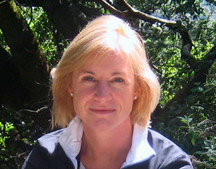INTERVIEW
Never Underestimate The Strength Of A Trend
Classic Swing Trading
With Linda Bradford Raschke
Hers is a name that you’ve probably heard or read any number of times if youíve been interested in or involved in technical analysis for very long. Linda Bradford Raschke began her trading career in 1981 on the floor of the Pacific Coast Stock Exchange before moving to the Philadelphia Stock Exchange, eventually trading her own account from home.
Stocks & Commodities Editor Jayanthi Gopalakrishnan (JG) and Staff Writer Bruce Faber (BF) spoke to Raschke via telephone on December 4, 2008.

The one thing technical
analysis cannot do
is predict where something is going
to go.
JG: Linda, how did you get interested in trading?
It was when I was just out of college and I had these glamorous ideas that I was going to be a stockbroker. I had moved to San Francisco and applied to every firm in the city, and got turned down by all of them.
BF: They are kicking themselves now.
Of course nobody wanted a kid out of college with no experience. So I ended up taking a job at Crown Zellerbach, which was right across the street from the Pacific Coast Stock Exchange. Every morning I would see these traders going in and out of the exchange wearing their trading jackets. I befriended one of them who taught me about options, and then I went through this course that the clearing firm offered at the time on how to price them. This was in equity options. After about six months, my friend the trader saw that I was still interested and offered to back me if I wanted to become a floor trader. In those days — this was back in 1981 — we did not have computers or online trading. The only access we had to a short-term trading environment was to go to one of the exchanges and work your way up by clerking or whatever you could do at the time.
I got lucky and got backing to become a trader, and thatís how I started. In this business, you learn by doing. I cannot stress that enough.
JG: You started out working on the floor and after that, you just ventured out on your own?
That trader backed me to become a floor trader. A short while after that, I got caught in a takeover bid in 1982 where I was on the wrong side. That pretty much put me into debt to my clearing firm. They found another company that needed a floor trader to execute some of their orders and strategies for them on that particular exchange, so thatís what I did for the next two years before I eventually moved to the Philadelphia Stock Exchange. I still owed money to the clearing firm, but I found another backer, and it took me about five years to pay off that trading loss. But eventually I made enough money to go out on my own.